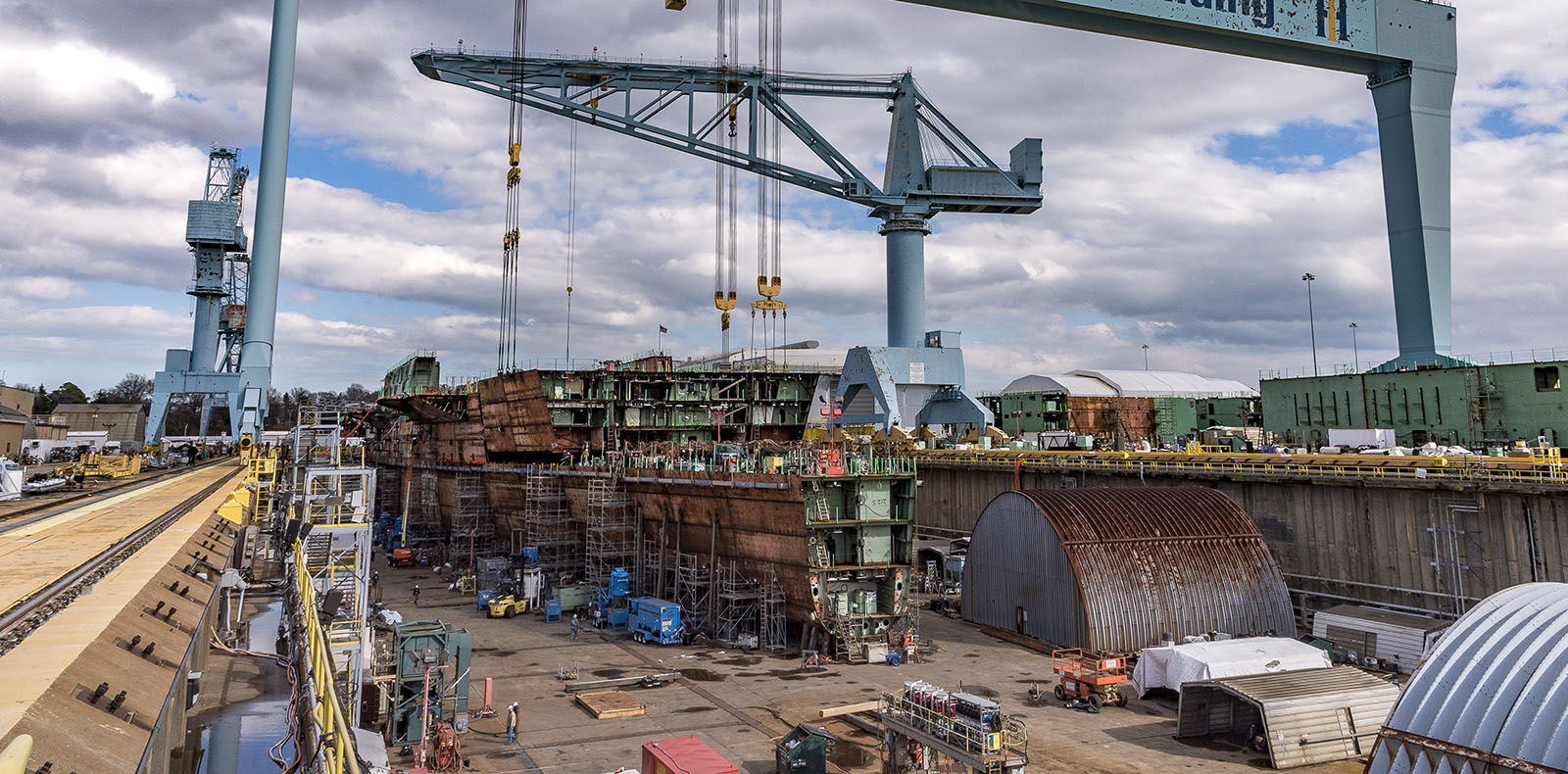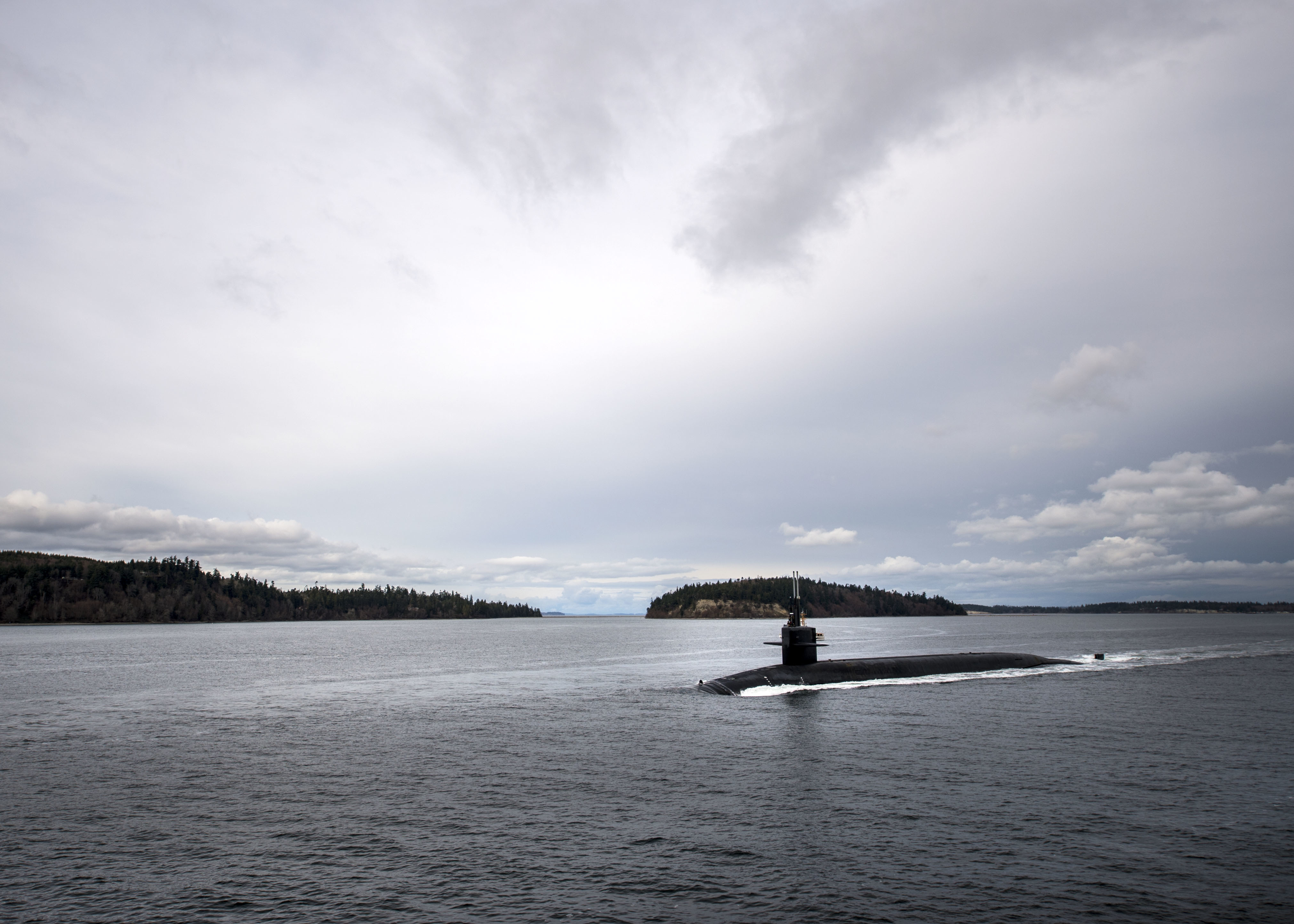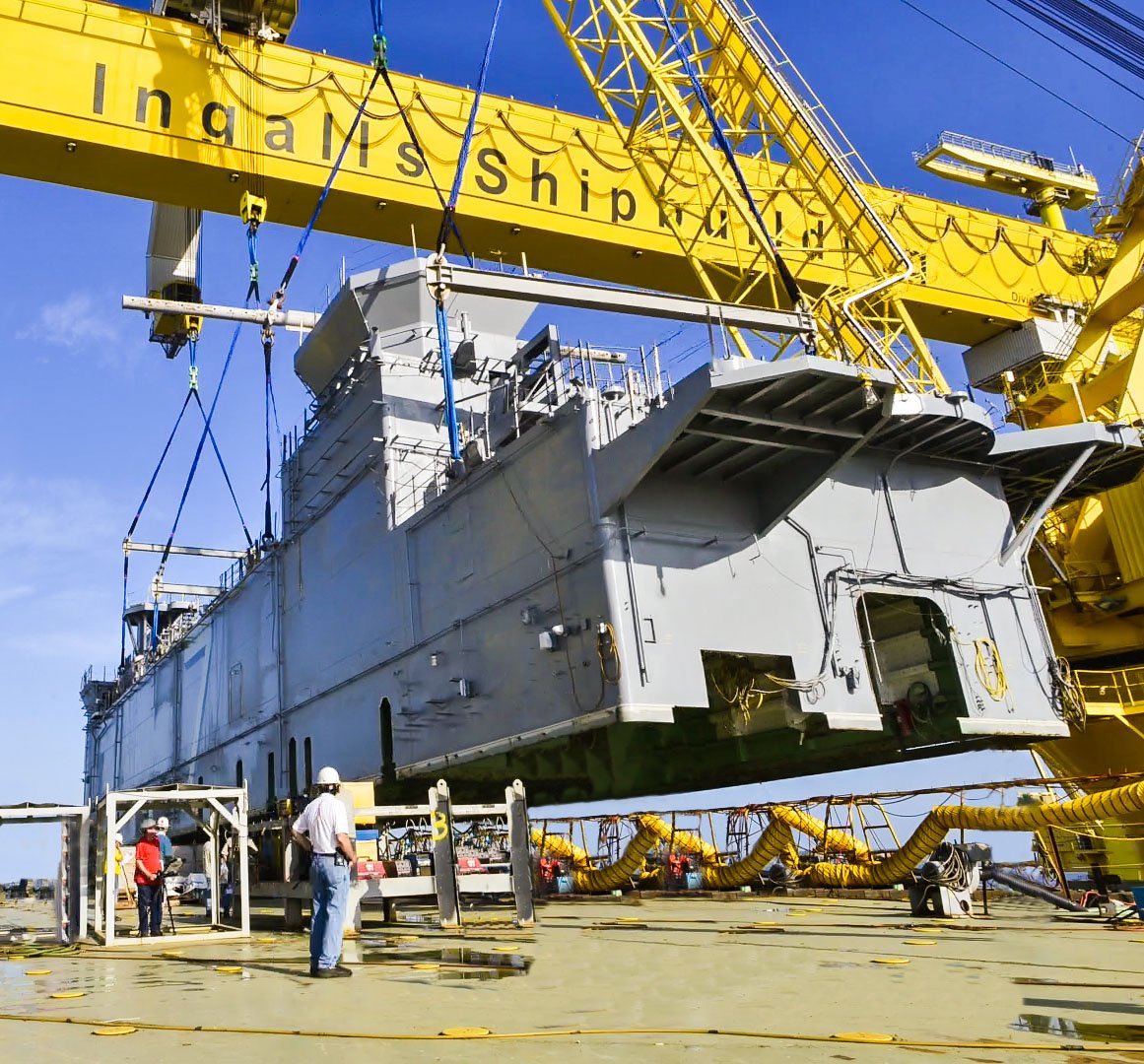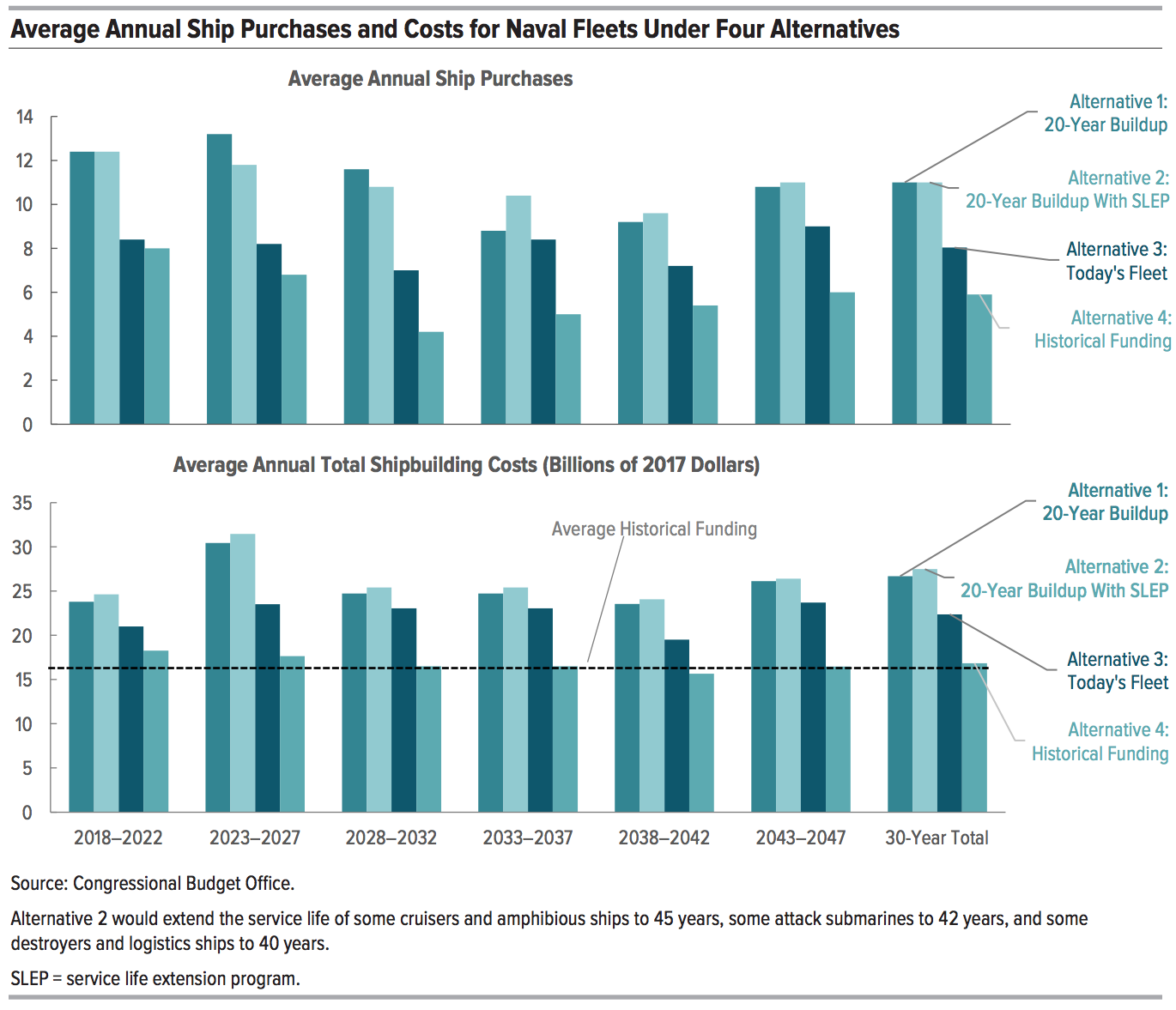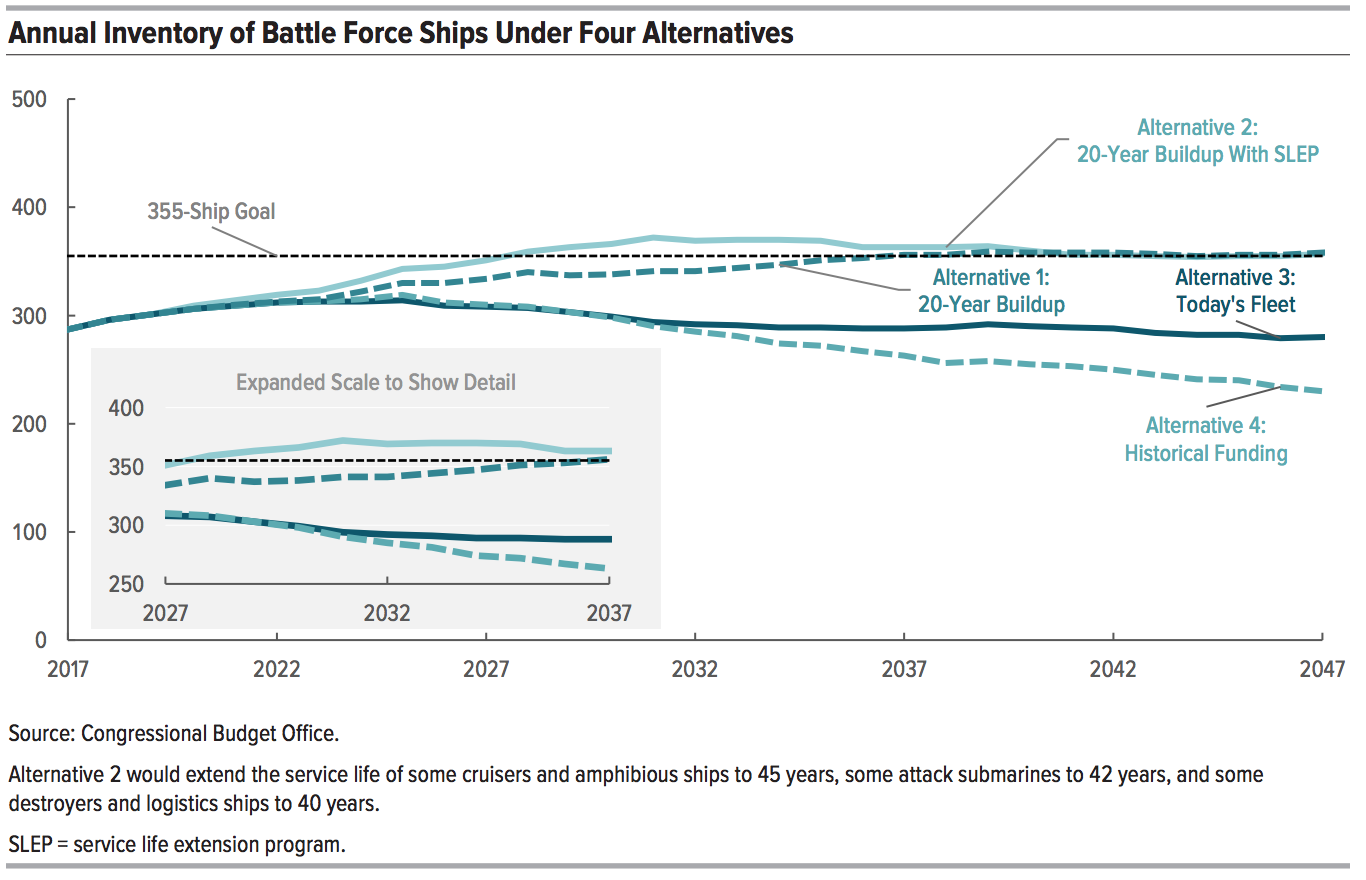- Joined
- Nov 29, 2016
- Messages
- 5,674
- Points
- 63
https://mil.news.sina.com.cn/world/2018-11-24/doc-ihpevhck4644103.shtml
美国民主党欲叫停美军355舰队造舰计划:真没钱了
2018年11月24日 14:31 观察者网
0
原标题:民主党欲叫停美国海军355舰队计划:先造弹道导弹核潜艇
[文/观察者网 王世纯]在民主党赢下众议院以后,民主党议员告诉美国海军,由于预算有限,海军只能在新弹道导弹核潜艇项目和“355舰大舰队”中间二选一。
民主党不喜欢大舰队
据美国海军协会网站(USNI)11月23日报道,本周,防卫预算方面的智库“布鲁金斯学会”就国防预算问题召开会议,该智库与国会关系密切的研究员表示,美国海军将被迫在“换装弹道导弹核潜艇”还是“建造355舰大舰队”中做出抉择。这意味着民主党可能要否定特朗普时代“355舰”的庞大造舰计划。
特朗普竞选时就承诺要扩充美国海军,将美国海军的舰队规模从“208艘”扩大到“355艘”。2018年初,美国国防策略转向“大国竞争”,美国海军随后发布《舰队结构评估报告》与《30年造舰计划》,评估了355舰的发展方向。
虽然国会和海军都认为美国海军目前确实缺乏水面舰艇,不过国会和海军内部都没有对《三十年造舰计划》达成一致,众议院此前为355舰争吵不断。

美国海军计划在未来30年建造12艘航母,11艘弹道导弹核潜艇,70条攻击核潜艇与100多条驱逐舰 图源:美国国会

除了与中俄竞争,美国海军此次扩军计划是为了维持美国国防造船业,要知道全世界目前只有美国海军才会买美国造船厂生产的船只 图源:美国国会
随着2018年民主党重新赢得众议院多数席位,民主党的众议院们也将控制军事委员会。“355舰”计划将面临民主党的质疑。
USNI的记者采访了负责军备控制的前助理国务卿弗兰克·罗斯,目前他担任布鲁金斯学会高级研究员。他表示,在民主党控制众议院的时代,民主党将会告诉美国海军两件事,第一,美国没有足够多的钱同时发展弹道导弹核潜艇与大舰队;第二,海军要发展“优先需要”的项目,也就是对国运至关重要的核反击潜艇。
罗斯和吉姆·米勒,前国防部的副部长,民主党的高级军事顾问,都坚定地认为海军必须把资金优先用于建造哥伦比亚级弹道导弹潜艇,这反应了民主党对于“哥伦比亚”级的态度。

俄亥俄级弹道导弹潜艇“路易斯安那”号 USS Louisiana (SSBN-743) 图源:USNI
民主党认为,在美军的核策略中,弹道导弹核潜艇是最为重要的一环,他确保了美国战略部队“核还击”的能力。在“俄亥俄”级弹道导弹潜艇逐渐老化的2018年,建造哥伦比亚级核潜艇至关重要。
预计明年1月新一届国会召开时,华盛顿州民主党众议员亚当·史密斯(Adam Smith,和那位著名的经济学家同名),将出任众议院军事委员会(House Armed Services Committee)主席。作为民主党军事方面的权威,亚当很不喜欢特朗普提出来的355舰计划,他称“355艘战舰”是“随口胡诌出来的数字”。

众议院军事委员会的高级成员亚当·斯密,值得一提的是,民主党军事委员会的成员目前依旧由高学历的建制派白人担当 图源:美国国会
共和党也干了
祸不单行,随着特朗普削减军费,共和党也开始考虑预算分配问题。20日,由共和党控制的参议院军事委员会(Senate Armed Services Committee)将审议国防战略委员会(commission on the National Defense Strategy)的有关美国核力量发展的建议。
同日下午,该委员会的海权小组委员会(sea power subcommittee)也开始审议当前和未来的造船计划。
布鲁斯金学会研究员表示,本次中期选举,共和党在部分郊区选区和农村选区输给了民主党,这警示了共和党。共和党现在要考虑宏观的预算分配问题,他们要照顾自己的支持者,而不是一味的把预算倾斜到军费上。
前国防部副部长米勒表示,海军不能放弃发展“战略威慑中俄”的能力。
日前,特朗普一反常态削减了军费,美国国防部原计划在2020财年拨款7330亿美元,但现在美国管理和预算办公室(Office of Management and Budget)要求国防部削减军费到7000亿美元。特朗普在军费问题的朝令夕改让美军四个军种都陷入了混乱,很多特朗普时代立项的武器研发与采购计划,包括新型巡航导弹,新的战略反导系统和陆军扩军计划被迫在军费削减的情况下暂停。
 特朗普要求内阁削减军费 图源:CNN
特朗普要求内阁削减军费 图源:CNN
现在看来,在军费上被称为“一等人”的美国海军,也不得不停止355舰发展计划。
随着美国在东北亚,也就是中国附近集结了两个航母打击大队和一半以上的水面舰艇。这使得美国仅剩一个航母战斗群去控制从西欧到中东宽达四分之一个地球的海域。从6月份到11月份,美国海军10年来首次在中东缺乏航母。

图为菲律宾海域的“里根”号与“斯坦尼斯”号航母 美国海军3分之2的兵力驻扎在亚太区域 图源:施佬
USNI记者就美国海军近年来缺乏水面舰艇问题,询问了布鲁斯金协会的高级研究员奥汉隆(Michael O ‘Hanlon)。
奥汉隆表示,美国海军不应该再像以前那样把兵力散往全世界,在几个月没有航母存在的情况下,伊朗没有采取更激进的行动,这证明波斯湾和中东地区并不需要航母战斗群。美国海军应该保持一支小规模的机动兵力,而不是大规模的常驻兵力。
The US Democratic Party wants to stop the US Army 355 fleet shipbuilding plan: really no money
November 24, 2018 14:31 Observer Network
0
Original title: Democrats want to stop the US Navy 355 Fleet plan: first to build ballistic missile nuclear submarines
After the Democratic Party won the House of Representatives, the Democratic Party members told the US Navy that due to the limited budget, the Navy could only choose between the new ballistic missile submarine project and the "355 ship fleet."
The Democratic Party does not like the big fleet
According to the US Navy Association website (USNI) reported on November 23, this week, the defense budget budget think tank "Brookings Society" held a meeting on defense budget issues, the think tank and the close relationship with the Congress said that the US Navy will be Forced to make a choice between "replacement of ballistic missile submarines" or "building a 355 ship fleet." This means that the Democratic Party may have to negate the huge shipbuilding plan of the Trump era "355 ship."
During Trump's campaign, he promised to expand the US Navy and expand the fleet size of the US Navy from "208 ships" to "355 ships." At the beginning of 2018, the US defense strategy turned to "great power competition." The US Navy subsequently issued the "Fleet Structure Assessment Report" and the "30-year Shipbuilding Plan" to assess the development direction of the 355 ship.
Although both the Congress and the Navy believe that the US Navy does not currently have a surface ship, there is no agreement within the Congress and the Navy on the Thirty Years Shipbuilding Plan. The House of Representatives has been arguing for the 355 ship.
The US Navy plans to build 12 aircraft carriers, 11 ballistic missile nuclear submarines, 70 attack nuclear submarines and more than 100 destroyers in the next 30 years.
In addition to competing with China and Russia, the US Navy's expansion plan is to maintain the US defense shipbuilding industry. It is necessary to know that only the US Navy will buy ships produced by American shipyards. Source: US Congress
With the Democratic Party regaining a majority in the House of Representatives in 2018, the House of Representatives of the Democratic Party will also control the military committee. The "355 Ship" plan will face the challenge of the Democratic Party.
USNI reporters interviewed former Assistant Secretary of State for Arms Control, Frank Rose, who is currently a senior fellow at the Brookings Institution. He said that in the era when the Democratic Party controls the House of Representatives, the Democratic Party will tell the US Navy two things. First, the United States does not have enough money to develop ballistic missile submarines and large fleets at the same time. Second, the Navy needs to develop "priority needs" projects. It is also a nuclear counter-submarine that is vital to the national movement.
Ross and Jim Miller, former deputy minister of defense, and senior military adviser to the Democratic Party, firmly believe that the Navy must prioritize the use of funds to build Colombian ballistic missile submarines, reflecting the Democratic Party’s attitude toward the "Colombia" class.
Ohio-class ballistic missile submarine "Louisiana" USS Louisiana (SSBN-743) Source: USNI
The Democratic Party believes that in the US military's nuclear strategy, ballistic missile nuclear submarines are the most important part, and he has ensured the ability of the US strategic forces to "nuclear counterattacks." In the 2018, when the "Ohio" class ballistic missile submarine became aging, the construction of a Columbian nuclear submarine was essential.
When the new Congress is expected in January next year, Washington State Democrat Adam Smith (the same name as the famous economist) will serve as chairman of the House Armed Services Committee. As the authority of the Democratic Party's military, Adam did not like Trump's proposed 355 ship plan. He called the "355 battleships" the "numbers that came out of the mouth."
Adam Smith, a senior member of the House Military Committee, it is worth mentioning that members of the Democratic Military Committee are still served by highly educated whites.
The Republican Party has also done it.
The disaster is not alone. As Trump cuts military spending, the Republican Party also began to consider the issue of budget allocation. On the 20th, the Republican-controlled Senate Armed Services Committee will review the recommendations of the National Defense Strategy on the development of US nuclear power.
On the afternoon of the same day, the committee's sea power subcommittee also began to consider current and future shipbuilding plans.
Researchers at the Bruce King Institute said that in this midterm election, the Republican Party lost to the Democratic Party in some suburban and rural constituencies, warning the Republican Party. The Republican Party now has to consider the macro budget allocation problem. They have to take care of their supporters instead of blindly tilting the budget to military spending.
Former Deputy Defense Minister Miller said that the Navy cannot give up the ability to develop "strategic deterrence of China and Russia."
A few days ago, Trump unscrupulously cut military spending. The US Department of Defense originally planned to allocate $733 billion in fiscal year 2020, but now the Office of Management and Budget requires the Defense Department to cut military spending to $700 billion. Trump’s military policy has changed the four US military services into chaos. Many Trump-era weapons development and procurement programs, including new cruise missiles, new strategic anti-missile systems, and Army expansion plans are forced into military spending. Suspended in case of cuts.
Trump asks the cabinet to cut military spending. Source: CNN Trump asks the cabinet to cut military spending. Source: CNN
It now appears that the US Navy, known as the "first class" in military spending, has to stop the 355 ship development plan.
As the United States assembled two aircraft carrier strike teams and more than half of surface ships in Northeast Asia, China. This left the United States with only one carrier battle group to control the waters of a quarter of the Earth from Western Europe to the Middle East. From June to November, the US Navy lacked an aircraft carrier for the first time in the Middle East in 10 years.
The picture shows the “Reagan” and “Stannis” aircraft carriers in the Philippine waters. Two-thirds of the US Navy’s troops are stationed in the Asia-Pacific region.
The USNI reporter asked Michael O ‘Hanlon, a senior researcher at the Bruce Gold Association, about the lack of surface ships in the US Navy in recent years.
O'Hanlon said that the US Navy should not disperse its troops to the world as before. In the absence of an aircraft carrier for several months, Iran has not taken more radical actions, which proves that the Persian Gulf and the Middle East do not need aircraft carriers. Battle group. The US Navy should maintain a small-scale mobile force rather than a large-scale permanent force.
美国民主党欲叫停美军355舰队造舰计划:真没钱了
2018年11月24日 14:31 观察者网
0
原标题:民主党欲叫停美国海军355舰队计划:先造弹道导弹核潜艇
[文/观察者网 王世纯]在民主党赢下众议院以后,民主党议员告诉美国海军,由于预算有限,海军只能在新弹道导弹核潜艇项目和“355舰大舰队”中间二选一。
民主党不喜欢大舰队
据美国海军协会网站(USNI)11月23日报道,本周,防卫预算方面的智库“布鲁金斯学会”就国防预算问题召开会议,该智库与国会关系密切的研究员表示,美国海军将被迫在“换装弹道导弹核潜艇”还是“建造355舰大舰队”中做出抉择。这意味着民主党可能要否定特朗普时代“355舰”的庞大造舰计划。
特朗普竞选时就承诺要扩充美国海军,将美国海军的舰队规模从“208艘”扩大到“355艘”。2018年初,美国国防策略转向“大国竞争”,美国海军随后发布《舰队结构评估报告》与《30年造舰计划》,评估了355舰的发展方向。
虽然国会和海军都认为美国海军目前确实缺乏水面舰艇,不过国会和海军内部都没有对《三十年造舰计划》达成一致,众议院此前为355舰争吵不断。

美国海军计划在未来30年建造12艘航母,11艘弹道导弹核潜艇,70条攻击核潜艇与100多条驱逐舰 图源:美国国会

除了与中俄竞争,美国海军此次扩军计划是为了维持美国国防造船业,要知道全世界目前只有美国海军才会买美国造船厂生产的船只 图源:美国国会
随着2018年民主党重新赢得众议院多数席位,民主党的众议院们也将控制军事委员会。“355舰”计划将面临民主党的质疑。
USNI的记者采访了负责军备控制的前助理国务卿弗兰克·罗斯,目前他担任布鲁金斯学会高级研究员。他表示,在民主党控制众议院的时代,民主党将会告诉美国海军两件事,第一,美国没有足够多的钱同时发展弹道导弹核潜艇与大舰队;第二,海军要发展“优先需要”的项目,也就是对国运至关重要的核反击潜艇。
罗斯和吉姆·米勒,前国防部的副部长,民主党的高级军事顾问,都坚定地认为海军必须把资金优先用于建造哥伦比亚级弹道导弹潜艇,这反应了民主党对于“哥伦比亚”级的态度。

俄亥俄级弹道导弹潜艇“路易斯安那”号 USS Louisiana (SSBN-743) 图源:USNI
民主党认为,在美军的核策略中,弹道导弹核潜艇是最为重要的一环,他确保了美国战略部队“核还击”的能力。在“俄亥俄”级弹道导弹潜艇逐渐老化的2018年,建造哥伦比亚级核潜艇至关重要。
预计明年1月新一届国会召开时,华盛顿州民主党众议员亚当·史密斯(Adam Smith,和那位著名的经济学家同名),将出任众议院军事委员会(House Armed Services Committee)主席。作为民主党军事方面的权威,亚当很不喜欢特朗普提出来的355舰计划,他称“355艘战舰”是“随口胡诌出来的数字”。

众议院军事委员会的高级成员亚当·斯密,值得一提的是,民主党军事委员会的成员目前依旧由高学历的建制派白人担当 图源:美国国会
共和党也干了
祸不单行,随着特朗普削减军费,共和党也开始考虑预算分配问题。20日,由共和党控制的参议院军事委员会(Senate Armed Services Committee)将审议国防战略委员会(commission on the National Defense Strategy)的有关美国核力量发展的建议。
同日下午,该委员会的海权小组委员会(sea power subcommittee)也开始审议当前和未来的造船计划。
布鲁斯金学会研究员表示,本次中期选举,共和党在部分郊区选区和农村选区输给了民主党,这警示了共和党。共和党现在要考虑宏观的预算分配问题,他们要照顾自己的支持者,而不是一味的把预算倾斜到军费上。
前国防部副部长米勒表示,海军不能放弃发展“战略威慑中俄”的能力。
日前,特朗普一反常态削减了军费,美国国防部原计划在2020财年拨款7330亿美元,但现在美国管理和预算办公室(Office of Management and Budget)要求国防部削减军费到7000亿美元。特朗普在军费问题的朝令夕改让美军四个军种都陷入了混乱,很多特朗普时代立项的武器研发与采购计划,包括新型巡航导弹,新的战略反导系统和陆军扩军计划被迫在军费削减的情况下暂停。

现在看来,在军费上被称为“一等人”的美国海军,也不得不停止355舰发展计划。
随着美国在东北亚,也就是中国附近集结了两个航母打击大队和一半以上的水面舰艇。这使得美国仅剩一个航母战斗群去控制从西欧到中东宽达四分之一个地球的海域。从6月份到11月份,美国海军10年来首次在中东缺乏航母。

图为菲律宾海域的“里根”号与“斯坦尼斯”号航母 美国海军3分之2的兵力驻扎在亚太区域 图源:施佬
USNI记者就美国海军近年来缺乏水面舰艇问题,询问了布鲁斯金协会的高级研究员奥汉隆(Michael O ‘Hanlon)。
奥汉隆表示,美国海军不应该再像以前那样把兵力散往全世界,在几个月没有航母存在的情况下,伊朗没有采取更激进的行动,这证明波斯湾和中东地区并不需要航母战斗群。美国海军应该保持一支小规模的机动兵力,而不是大规模的常驻兵力。
The US Democratic Party wants to stop the US Army 355 fleet shipbuilding plan: really no money
November 24, 2018 14:31 Observer Network
0
Original title: Democrats want to stop the US Navy 355 Fleet plan: first to build ballistic missile nuclear submarines
After the Democratic Party won the House of Representatives, the Democratic Party members told the US Navy that due to the limited budget, the Navy could only choose between the new ballistic missile submarine project and the "355 ship fleet."
The Democratic Party does not like the big fleet
According to the US Navy Association website (USNI) reported on November 23, this week, the defense budget budget think tank "Brookings Society" held a meeting on defense budget issues, the think tank and the close relationship with the Congress said that the US Navy will be Forced to make a choice between "replacement of ballistic missile submarines" or "building a 355 ship fleet." This means that the Democratic Party may have to negate the huge shipbuilding plan of the Trump era "355 ship."
During Trump's campaign, he promised to expand the US Navy and expand the fleet size of the US Navy from "208 ships" to "355 ships." At the beginning of 2018, the US defense strategy turned to "great power competition." The US Navy subsequently issued the "Fleet Structure Assessment Report" and the "30-year Shipbuilding Plan" to assess the development direction of the 355 ship.
Although both the Congress and the Navy believe that the US Navy does not currently have a surface ship, there is no agreement within the Congress and the Navy on the Thirty Years Shipbuilding Plan. The House of Representatives has been arguing for the 355 ship.
The US Navy plans to build 12 aircraft carriers, 11 ballistic missile nuclear submarines, 70 attack nuclear submarines and more than 100 destroyers in the next 30 years.
In addition to competing with China and Russia, the US Navy's expansion plan is to maintain the US defense shipbuilding industry. It is necessary to know that only the US Navy will buy ships produced by American shipyards. Source: US Congress
With the Democratic Party regaining a majority in the House of Representatives in 2018, the House of Representatives of the Democratic Party will also control the military committee. The "355 Ship" plan will face the challenge of the Democratic Party.
USNI reporters interviewed former Assistant Secretary of State for Arms Control, Frank Rose, who is currently a senior fellow at the Brookings Institution. He said that in the era when the Democratic Party controls the House of Representatives, the Democratic Party will tell the US Navy two things. First, the United States does not have enough money to develop ballistic missile submarines and large fleets at the same time. Second, the Navy needs to develop "priority needs" projects. It is also a nuclear counter-submarine that is vital to the national movement.
Ross and Jim Miller, former deputy minister of defense, and senior military adviser to the Democratic Party, firmly believe that the Navy must prioritize the use of funds to build Colombian ballistic missile submarines, reflecting the Democratic Party’s attitude toward the "Colombia" class.
Ohio-class ballistic missile submarine "Louisiana" USS Louisiana (SSBN-743) Source: USNI
The Democratic Party believes that in the US military's nuclear strategy, ballistic missile nuclear submarines are the most important part, and he has ensured the ability of the US strategic forces to "nuclear counterattacks." In the 2018, when the "Ohio" class ballistic missile submarine became aging, the construction of a Columbian nuclear submarine was essential.
When the new Congress is expected in January next year, Washington State Democrat Adam Smith (the same name as the famous economist) will serve as chairman of the House Armed Services Committee. As the authority of the Democratic Party's military, Adam did not like Trump's proposed 355 ship plan. He called the "355 battleships" the "numbers that came out of the mouth."
Adam Smith, a senior member of the House Military Committee, it is worth mentioning that members of the Democratic Military Committee are still served by highly educated whites.
The Republican Party has also done it.
The disaster is not alone. As Trump cuts military spending, the Republican Party also began to consider the issue of budget allocation. On the 20th, the Republican-controlled Senate Armed Services Committee will review the recommendations of the National Defense Strategy on the development of US nuclear power.
On the afternoon of the same day, the committee's sea power subcommittee also began to consider current and future shipbuilding plans.
Researchers at the Bruce King Institute said that in this midterm election, the Republican Party lost to the Democratic Party in some suburban and rural constituencies, warning the Republican Party. The Republican Party now has to consider the macro budget allocation problem. They have to take care of their supporters instead of blindly tilting the budget to military spending.
Former Deputy Defense Minister Miller said that the Navy cannot give up the ability to develop "strategic deterrence of China and Russia."
A few days ago, Trump unscrupulously cut military spending. The US Department of Defense originally planned to allocate $733 billion in fiscal year 2020, but now the Office of Management and Budget requires the Defense Department to cut military spending to $700 billion. Trump’s military policy has changed the four US military services into chaos. Many Trump-era weapons development and procurement programs, including new cruise missiles, new strategic anti-missile systems, and Army expansion plans are forced into military spending. Suspended in case of cuts.
Trump asks the cabinet to cut military spending. Source: CNN Trump asks the cabinet to cut military spending. Source: CNN
It now appears that the US Navy, known as the "first class" in military spending, has to stop the 355 ship development plan.
As the United States assembled two aircraft carrier strike teams and more than half of surface ships in Northeast Asia, China. This left the United States with only one carrier battle group to control the waters of a quarter of the Earth from Western Europe to the Middle East. From June to November, the US Navy lacked an aircraft carrier for the first time in the Middle East in 10 years.
The picture shows the “Reagan” and “Stannis” aircraft carriers in the Philippine waters. Two-thirds of the US Navy’s troops are stationed in the Asia-Pacific region.
The USNI reporter asked Michael O ‘Hanlon, a senior researcher at the Bruce Gold Association, about the lack of surface ships in the US Navy in recent years.
O'Hanlon said that the US Navy should not disperse its troops to the world as before. In the absence of an aircraft carrier for several months, Iran has not taken more radical actions, which proves that the Persian Gulf and the Middle East do not need aircraft carriers. Battle group. The US Navy should maintain a small-scale mobile force rather than a large-scale permanent force.

